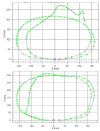Injury patterns in side pole crashes
- PMID: 18184505
- PMCID: PMC3217499
Injury patterns in side pole crashes
Abstract
Side impact pole/tree crashes can have devastating consequences. A series of 53 CIREN cases of narrow-object side impacts were analyzed. Twenty-seven of 53 had serious chest injury and 27 had serious head injury. Unilateral chest trauma led to the examination of residual crush pattern that often demonstrated oblique door intrusion into the occupant thorax space. It was hypothesized that unilateral chest trauma was caused by antero-lateral chest loading. This hypothesis was evaluated by conducting two (PMHS and ES2) vehicle side impact tests into a rigid pole. The PMHS test produced an oblique chest deformation pattern with injuries very similar to the real world trauma: unilateral rib fractures, spleen laceration, pelvic fracture, and a basilar skull fracture. Narrow-object side impacts are severe crash environments that can induce oblique chest loading and unique head trauma. Because the human may be more vulnerable in this type of crash scenario, dummy response and measurements, as well as a re-examination of side injury criteria may be necessary to design appropriate injury-mitigating safety devices.
Figures














Similar articles
-
Evaluation of near-side oblique frontal impacts using THOR with SD3 shoulder.Traffic Inj Prev. 2014;15 Suppl 1:S96-102. doi: 10.1080/15389588.2014.934367. Traffic Inj Prev. 2014. PMID: 25307404
-
Factors affecting pelvic and thoracic forces in near-side impact crashes: a study of US-NCAP, NASS, and CIREN data.Accid Anal Prev. 2005 Mar;37(2):287-93. doi: 10.1016/j.aap.2004.09.005. Accid Anal Prev. 2005. PMID: 15667815
-
Assessment of Bilateral Thoracic Loading on the Near-Side Occupant Due to Occupant-to-Occupant Interaction in Vehicle Crash Tests.Traffic Inj Prev. 2015;16 Suppl 2:S217-23. doi: 10.1080/15389588.2015.1061665. Traffic Inj Prev. 2015. PMID: 26436235
-
Injury prediction in a side impact crash using human body model simulation.Accid Anal Prev. 2014 Mar;64:1-8. doi: 10.1016/j.aap.2013.10.026. Epub 2013 Oct 30. Accid Anal Prev. 2014. PMID: 24316501
-
Lateral impact injuries with side airbag deployments--a descriptive study.Accid Anal Prev. 2007 Jan;39(1):22-7. doi: 10.1016/j.aap.2006.05.014. Epub 2006 Aug 14. Accid Anal Prev. 2007. PMID: 16911812 Free PMC article.
Cited by
-
Correlating the extent of pulmonary contusion to vehicle crash parameters in near-side impacts.Ann Adv Automot Med. 2011;55:217-30. Ann Adv Automot Med. 2011. PMID: 22105398 Free PMC article.
-
Biomechanical and injury response to posterolateral loading from torso side airbags.Stapp Car Crash J. 2010 Nov;54:227-57. doi: 10.4271/2010-22-0012. Stapp Car Crash J. 2010. PMID: 21512911 Free PMC article.
-
Effect of ESC (electronic stability control) on tree and pole impacts with focus on rear impacts.Heliyon. 2024 Sep 7;10(18):e37591. doi: 10.1016/j.heliyon.2024.e37591. eCollection 2024 Sep 30. Heliyon. 2024. PMID: 39347382 Free PMC article.
-
Oblique pole-side crash assessment using the six-year-old HBM PIPER.Heliyon. 2024 Aug 12;10(16):e35927. doi: 10.1016/j.heliyon.2024.e35927. eCollection 2024 Aug 30. Heliyon. 2024. PMID: 39247281 Free PMC article.
-
Technique for chestband contour shape-mapping in lateral impact.J Biomech. 2011 Aug 11;44(12):2328-32. doi: 10.1016/j.jbiomech.2011.05.029. Epub 2011 Jun 15. J Biomech. 2011. PMID: 21676399 Free PMC article.
References
-
- NHTSA Traffic Safety Facts-2005. National Center for Statistics and Analysis. National Highway Traffic Safety Administration, US Department of Transportation; Washington DC: 2005. - PubMed
-
- McGwin G, Metzger J, et al. Association between side air bags and risk of injury in motor vehicle collisions with near-side impact. J Trauma. 2003;55(3):430–436. - PubMed
-
- Pintar F, Yoganandan N, Hines M, et al. Chestband Analysis of Human Tolerance to Side Impact. 41st Stapp Car Conference Proceedings. 1997 Nov;:63–74.
Publication types
MeSH terms
LinkOut - more resources
Full Text Sources
Medical
